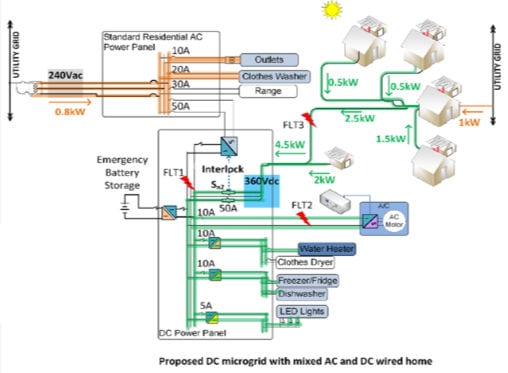Principal Investigator: Dr. Robert Cuzner
Community microgrids have emerged as an alternative to address the rising societal demands for electric infrastructures that are able to provide premium reliability and power quality levels while at the same time being economically and environmentally friendly. The focus of this project is a community microgrid that supplies electricity to a group of houses within a neighborhood or several connected neighborhoods in close proximity. Such a system provides a unique opportunity for every day consumers to take advantage of renewable energy resources, such as solar through shared use.
Further benefit comes through inter-connection of DC enabled smart homes which have the best chance of driving towards net zero energy usage. The benefit of DC interconnection of homes through a microgrid is lower cost and less complex integration of multiple shared energy sources and integration with energy storage. However, the most significant roadblock to such systems is the availability of safe and reliable protective distribution equipment. In conventional AC distribution, fault current is limited by the source impedance of the upstream distribution feed and the closer a fault is to that feed, the higher the fault current will be. Radial distribution of circuit breaker protected branches from the transformer feed to a house and then to the individual loads provides is a time-proven method for isolating a fault closest to its location. A DC fed home has very different characteristics when fault behavior is considered, especially if the DC distribution includes multiple sources of power such as Solar PV, Battery back-up and DC converted utility feed.

If a near zero-ohm fault is suddenly applied, the fault characteristic is dominated by energy storage on the bus and inter-connecting cables. So effective DC protective circuits must be able to discern faults and isolate them from the rest of the system on the order of microseconds. The purpose of this project is develop and test solid state circuit breaker based radial distribution systems that can act to isolate faults with minimal need for sensing circuitry and without inter-device communications. A unique approach is proposed which utilizes normally-on Wide Band Gap (WBG) Silicon Carbide (SiC) JFET or Gallium Nitride (GaN) HEMT devices as the fault interrupting solid state switch and a fast-starting isolated DC/DC converter as the protection driver.
The new SSCB detects short circuit faults by sensing its drain-source voltage rise, and draws power from the fault condition to turn and hold off the SiC JFET. This new circuit breaker technology offers a reaction time of 1-2μs, about 10X faster than any previously reported solid state circuit breakers and 10,000X faster than any mechanical circuit breakers.

Recent Comments